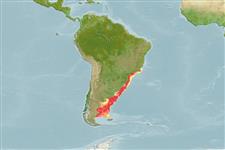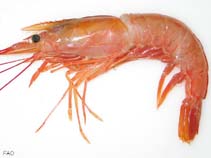Pleoticus muelleri (Bate, 1888)
Argentine red shrimp| Native range | All suitable habitat | Point map | Year 2050 |

|
| This map was computer-generated and has not yet been reviewed. |
| Pleoticus muelleri AquaMaps Data sources: GBIF OBIS |
Classification / Names Populärnamn | synonymer | CoL | ITIS | WoRMS
Malacostraca | Decapoda | Solenoceridae
Environment: milieu / climate zone / djupintervall / distribution range Ekologi
; djupintervall 2 - 174 m (Ref. 87391), usually 5 - 25 m (Ref. 8). Subtropical; 6°C - 20°C (Ref. 106926), preferred 13°C (Ref. 107945); 18°S - 50°S, 68°W - 39°W
Distribution Länder | FAO områden | Ekosystem | Förekomster | Utplanteringar
Southwest Atlantic: from Brazil to Argentina. Subtropical to temperate.
Length at first maturity / Size / Weight / Age
Könsmognad: Lm 2.0, range 1 - ? cm Max length : 19.0 cm TL hane/ej könsbestämd; (Ref. 86); common length : 10.0 cm TL hane/ej könsbestämd; (Ref. 86)
Life cycle and mating behavior Könsmognad | Reproduktion | Lek | Eggs | Fecundity | Larvae
Main reference
referenser | Koordinator | Medarbetare
Holthuis, L.B. 1980 FAO Species Catalogue. Vol. 1. Shrimps and prawns of the world. An annotated catalogue of species of interest to fisheries. FAO Fish. Synop. 125(1):271 p. Rome: FAO. (Ref. 8)
IUCN Red List Status
(Ref. 130435: Version 2025-1)
CITES status (Ref. 108899)
CMS (Ref. 116361)
Threat to humans
Human uses
Fiskeri: kommersiell
FAO - fiskeri: landings | FishSource | Sea Around Us
Verktyg
Ytterligare information
Max. ages / sizes
Length-weight rel.
Length-length rel.
Length-frequencies
Mass conversion
Abundans
Internet-källor
BHL | BOLD Systems | CISTI | DiscoverLife | FAO(fiskeri: ; publication : search) | Fishipedia | GenBank (genome, nucleotide) | GloBI | Gomexsi | Google Books | Google Scholar | Google | PubMed | Tree of Life | Wikipedia (Go, sök) | Zoological Record



